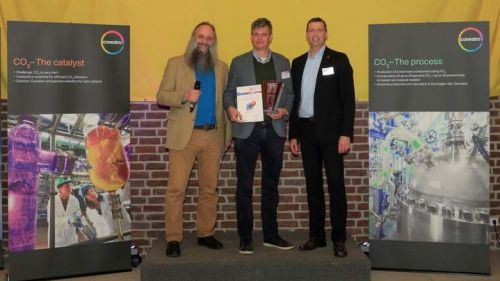本文转自《The Chemical Engineer》发表的题为“Carbon-negative concrete wins inaugural CCUS prize”的报道。
作者:Adam Duckett
日期:2019.04.18
原文链接:https://www.thechemicalengineer.com/news/carbon-negative-concrete-wins-inaugural-ccus-prize/?_lrsc=c60130c2-aea6-4377-8341-dc175f59d3fa&http://www.covestro.us/?WT.mc_id=Twitter&from=groupmessage&isappinstalled=0

Andrew Schmidt of Carbicrete (centre) accepts his award from Michael Carus (left) and Markus Steilemann (right)
Carbicrete的Andrew Schmidt(中)接受了Michael Carus(左)和Markus Steilemann(右)的颁奖
A CARBON-NEGATIVE form of concrete has won an inaugural prize that recognises the potential of using carbon dioxide as an industrial feedstock.
负碳形式的混凝土赢得了首个奖项,该奖项旨在表彰使用二氧化碳作为工业原料的潜力。
Carbicrete won the Best CO2 Utilisation prize for its process that produces cement-free, carbon-negative concrete. Ground steel slag, a byproduct of steel production, is used instead of cement, and the concrete is cured with CO2 instead of heat and steam. The company says that for each standard 18 kg concrete block produced using its process, it saves 2 kg of CO2 by avoiding the production of cement and locks up a further 1 kg of CO2 in the product itself during curing.
Carbicrete因其生产无水泥碳纤维混凝土的工艺而荣获最佳二氧化碳利用奖。 钢渣是钢铁生产过程中产生的一种副产品,用它来代替水泥,用二氧化碳来代替热量和蒸汽来固化混凝土。 该公司表示,每生产一个18公斤的标准混凝土砌块,就可以避免生产水泥,从而节省2公斤二氧化碳,并在固化过程中在产品本身中再锁住1公斤二氧化碳。
In 2018, Carbicrete won a C$2.1m (US$1.57m) grant from Sustainable Development Technology Canada to build a production facility at an existing concrete plant and reach commercial production by mid-2021.
2018年,Carbicrete从加拿大可持续发展技术委员会获得了210万加元(约合157万美元)的资金,用于在现有的混凝土工厂建造生产设施,并在2021年中期投入商业生产。
The award has been given by Germany’s nova-Institute, a research consultancy focussed on the bio- and CO2-based economy. It shortlisted six winners and then asked 200 experts gathered at the 7th Conference on Carbon Dioxide as Feedstock for Fuels, Chemistry and Polymers to pick the winner.
该奖项由德国新星研究所颁发,该研究所是一家专注于生物和二氧化碳经济的研究咨询公司。 它将六位获奖者列入候选名单,然后请第二届二氧化碳会议的200名燃料,化学和聚合物原料等领域的专家挑选获胜者。
Speaking on the sidelines of the event in March, nova-Institute Managing Director Michael Carus said: “When we are looking for all the wonderful products around made from chemical industry and the polymer and plastic industry, then they basically need carbon. So, in the future they cannot use any more of the fossil carbon…they have to move to other carbon sources.”
诺瓦研究所常务董事Michael Carus在3月份的会议期间发表讲话说:“当我们寻找化学工业和聚合物及塑料工业制造的所有优质产品时,他们基本上需要碳。 因此,未来他们不能再使用化石碳......他们必须转向其他碳源。“
Chemicals major Covestro sponsored the award. The company began producing plastics with CO2 captured from its operations in 2016. It uses CO2 to replace around 20% of the oil-derived propylene oxide conventionally used to produce polyols – a precursor in the production of polyurethane foams.
化学巨头Covestro创赞助该奖项。 该公司从2016年开始用从运营中收集的二氧化碳生产塑料。它使用二氧化碳代替约20%的常规用于生产多元醇的油衍生环氧丙烷 - 这是聚氨酯泡沫生产的前体。
Speaking at the awards ceremony, Covestro CEO Markus Steilemann said: “I think the chemical industry in principle can run without fossil fuels, and that’s the vision”.
在颁奖典礼上,Covestro首席执行官Markus Steilemann表示:“我认为原则上化学工业可以在没有化石燃料的情况下运行,这就是愿景”。
He said Covestro wants to increase the range of raw materials available for production and CO2 offers a potential alternative.
他表示,Covestro希望增加可用于生产的原材料范围,二氧化碳提供了一种潜在的替代方案。
“At the end of the day, I think it Is good to look into the future and also put your money where your mouth is, that means recognise people and award people who make great progress in this field.”
“在一天结束的时候,我认为展望未来,把钱花在刀刃上是件好事,这意味着认可在这个领域取得巨大进步的人,并奖励他们。”
Second prize was awarded to Nordic Blue Crude for using electrolysis to split water, direct air capture of CO2, and Fischer-Tropsch to produce synthetic crude.
第二名授予了北欧蓝原油公司,该公司利用电解分解水,直接捕捉空气中的二氧化碳,以及菲舍-托普希公司生产合成原油。
Third prize was given to b.fab, a startup that wants to convert CO2 and hydrogen into liquid formate and then use synthetic biology to create organisms that will convert the formate into chemicals.
三等奖给了b.fab,是一家创业公司,它想把二氧化碳和氢转化为液态甲酸盐,然后利用合成生物学来创造将甲酸盐转化为化学物质的生物体。